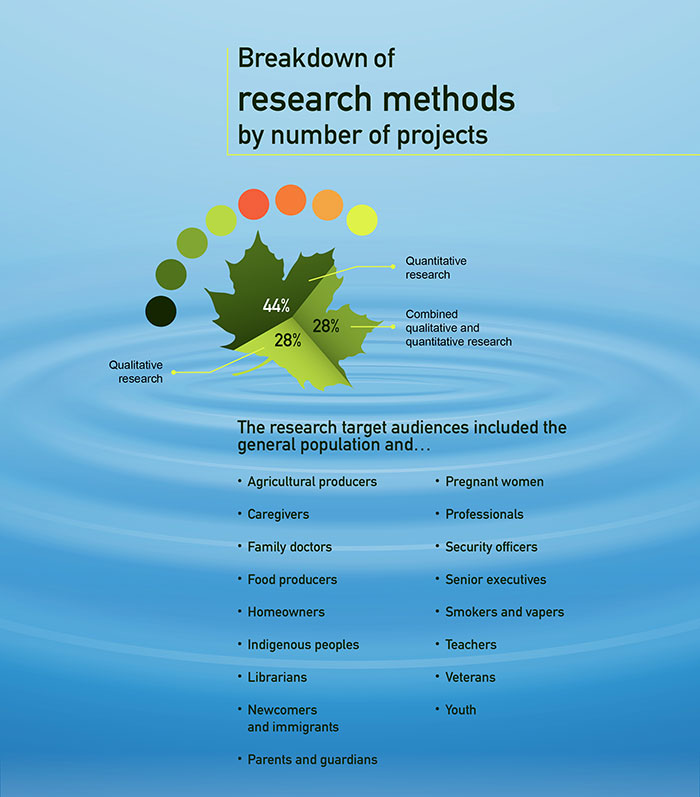The year in review—17th Annual report on Government of Canada public opinion research activities
Public opinion research (POR) projects undertaken in the 2017 to 2018 fiscal year were similar in number to those of the previous year. While the subject matter changes from year to year, the need for research to stimulate discussion and aid decision-making continues. In all, there were 124 projects contracted worth $11.9 million. This includes the purchase of 5 syndicated research studies that were shared among federal departments.
The projects show how public opinion research informs the government of the views of Canadians on a range of topics. As examples:
- Canada Revenue Agency spoke to business owners who had installed bitcoin ATMs
- Employment and Social Development Canada held focus groups to explore the need for, and barriers to, continuing education and skills development
- Health Canada obtained feedback on food safety issues and conducted a baseline survey on opioid awareness, knowledge and behaviours
- Transport Canada contacted a sample of the general public and a sample of Indigenous peoples, with a focus on coastal communities, to examine marine safety issues
- Department of Justice Canada surveyed Canadians’ attitudes towards the criminal justice system
Additional public opinion research projects were undertaken during the 2017 to 2018 fiscal year. For a full list of projects, turn to Appendix II of this report. Final reports for all completed research studies can be found on the Library and Archives Canada website.
We heard from many Canadians this year
Through the use of quantitative and qualitative techniques such as surveys and focus groups, the government obtained insightful and valuable information from Canadians. The information came from the general population and also from target audiences such as professionals, parents, caregivers, Indigenous people, youth and veterans.
The knowledge gained by using these research methods helped the government better understand many points of view and what mattered most to Canadians.
Figure 1: The breakdown of research methods by number of projects and the target audiences

Image description
Breakdown of research methods by number of projects:
- qualitative research: 28%
- quantitative research: 44%
- combined qualitative and quantitative research: 28%
The research target audience included the general population and:
- agricultural producers
- caregivers
- family doctors
- food producers
- homeowners
- Indigenous peoples
- librarians
- newcomers and immigrants
- parents and guardians
- pregnant women
- professionals
- security officers
- seniors executives
- smokers and vapers
- teachers
- veterans
- youth
Selected research findings
A small sample of things we learned through listening to Canadians this year:

Drinking water quality in First Nations communities
Health Canada conducted interviews on the topic of drinking water quality with 828 residents of First Nations communities and 721 residents from other small communities across Canada.
Compared to residents of other small communities, First Nations residents had a significantly higher demand for information to reassure them about their tap water quality:
66% of First Nations community residents interviewed would like to know more about what to do in case of a Drinking Water Advisory or a Boil Water Advisory, while three-quarters said that more information about water quality testing procedures (74%), and information about the quality of tap water in their community (72%), would make them feel safer.
These findings will help guide outreach activities in the future.
Source: Perceptions of Drinking Water Quality in First Nations Communities and General Population (registration number: POR 052-17)

Attitudes towards electric vehicles
Most Canadians (74%) want assurance of a driving range of 250 km or more on a single full charge and 39% want a 450 km driving range per full charge.
78% of current electric vehicle owners surveyed were very interested in buying another.
75% of respondents agreed that there are too few public charging stations.
Source: Consumer Attitudes Towards Electric Vehicles (registration number: POR 062-17)

How Canadians connect to government information
Canadians expect to receive information about government programs and services primarily through the Internet (84% reported).
41% of Internet users in Canada rely on social media (Facebook, YouTube, LinkedIn) to look for information on federal government programs, services and announcements.
Reliance on social media was equally high among linguistic minorities: both among Francophones outside Quebec (42%) and Anglophones in Quebec (47%).
Source: Media Habits of Minority Language Canadians (registration number: POR 084-16)

Helping Canadians make use of government services
58% of Canadians are very or somewhat comfortable with their personal information being shared automatically among federal departments as part of a single account approach for accessing government programs and services.
Source: Service Delivery and Privacy: Public Opinion Research (registration number: POR 092-17)
Project details are listed in Appendix II of this report.
K